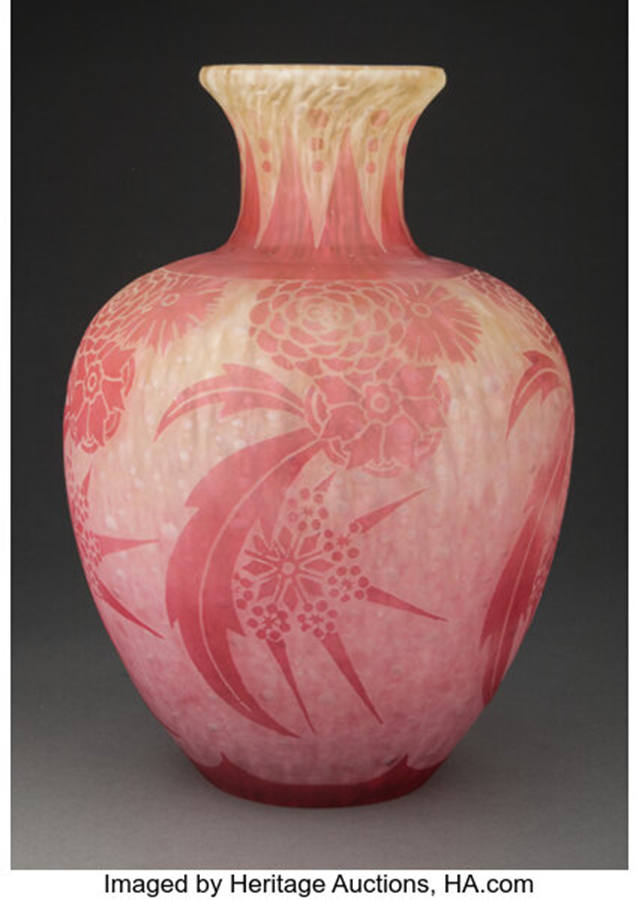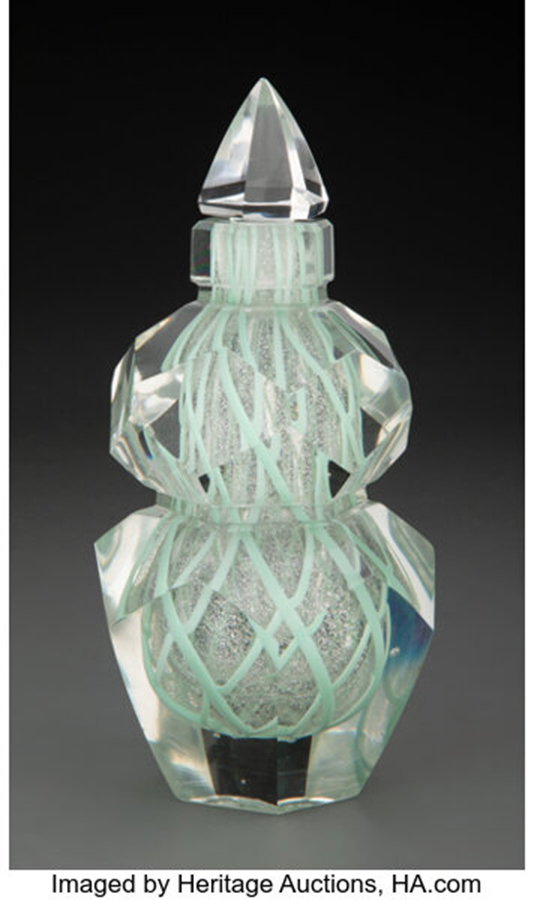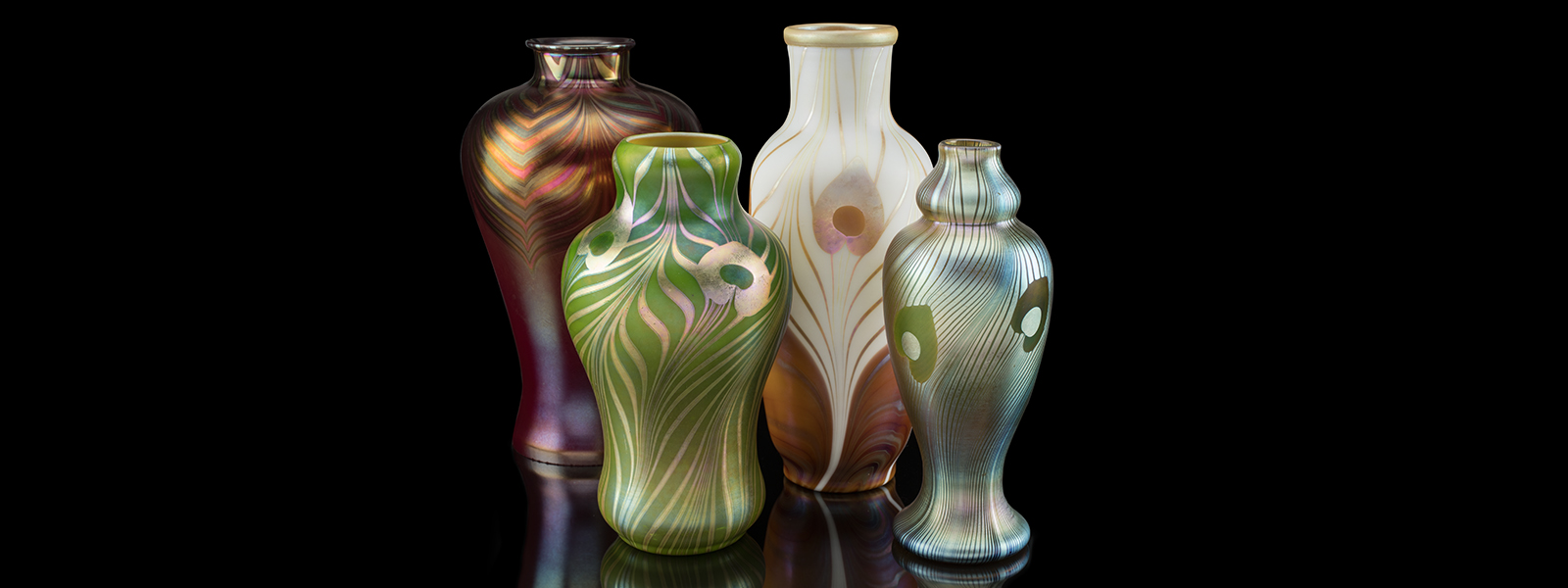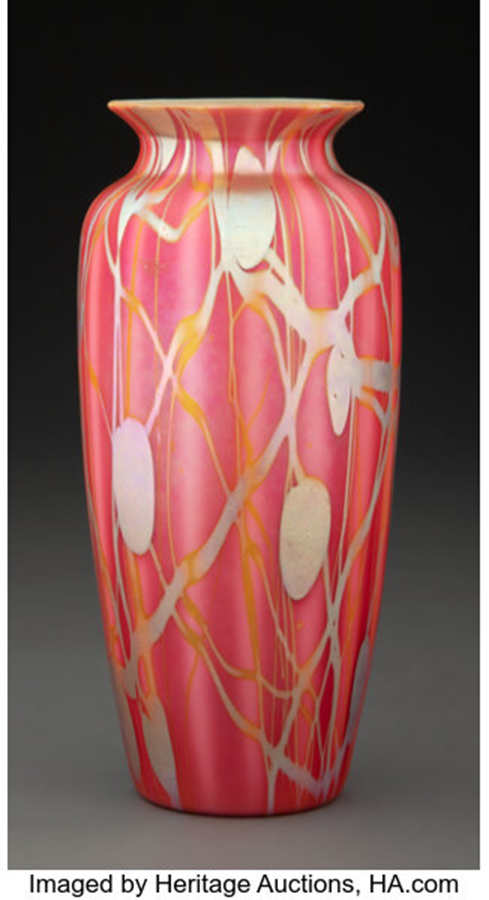A PRIMER ON THE INFLUENTIAL AMERICAN ART GLASS MANUFACTURER
By Samantha Robinson
Between 1880 and 1930, the production of glass reached its pinnacle both in Europe and in the United States. Throughout this period, techniques, styles, and even designers and gaffers themselves crisscrossed the ocean, resulting in many of the finest works ever produced in the highly technical medium. The story of one of the most prominent and influential manufacturers – Steuben Glass Works – is a result of this transatlantic exchange.
Enlarge

Steuben’s Frederick Carder Era
English-American artist and designer Frederick Carder was born in 1863 in Staffordshire, then a rapidly industrializing region with a long-standing tradition of ceramics and glass production. At 14 years old, Carder left school to work in his family’s firm Leys Pottery. In 1878, following study at the Stourbridge School of Art, he became a cutter for the premier cameo glass artist John Northwood, who had achieved fame for his copy of the Portland vase just two years prior. Carder soon secured the position of draftsman and designer at Stevens & Williams. There, he conducted analyses and experiments with the colorizing agents of glass, reintroducing colored glass wares that proved popular among the rapidly expanding bourgeoisie. Irish-American glassmaker Thomas G. Hawkes noticed the talents and achievements of Carder, whom he persuaded to relocate to Corning, New York, and establish and direct Steuben Glass Works in 1903. From 1903 through 1932, Carder oversaw Steuben’s operations, developing an array of colors, patterns and shapes.
Heritage Auctions’ January 26 Pursuit of Beauty: Art Nouveau, Art Deco & Art Glass auction will feature the first of two installments of an important private collection of Carder-era Steuben pieces from Waco, Texas. This collection demonstrates the range of the firm’s production under its first director.
Decorated Aurene
Steuben is best known for its wildly popular iridescent glass known as Aurene, a portmanteau of aurum (“gold” in Latin) and schene (a Middle English form of “sheen”). Carder first experimented with iridescent glass inspired by Roman artifacts while at Stevens & Williams in the 1890s. Simultaneously, his contemporary and rival Louis Comfort Tiffany developed glass with luminous and ever-shifting surfaces, which he dubbed Favrile (“handmade” in Old English) and premiered at the Paris Exposition of 1900. Carder then perfected his own formula over the next decade, producing not only gold but also blue, green, red and brown Aurene colors, occasionally featuring pulled feather, millefiori and other decoration. Carder’s Aurene glass was so technically advanced and commercially successful that it garnered the attention and ire of Tiffany Studios, which in 1913 levied a bill of complaint against Steuben, later dropped in 1914.
The private Waco collection features some of the rarest and most iconic decorated Steuben Aurene works.
Enlarge

Acid Etching
Given his experiences at Northwood and Stevens & Williams in England, it is no surprise that Carder established an acid-etching department in 1906, early in his tenure at Steuben. Steuben acid-etched objects typically consist of two layers of glass of different colors, with the top layer selectively coated in wax ink and then submerged in acid. The uncoated portions of the top layer would be removed, revealing a design in relief. This large hexagonal vase with the Art Deco Hunting scene of an archer in pursuit of a gazelle achieved in Blue Aurene on Jade Yellow (pictured above) is a desirable pattern in a rare color combination. Acid etching on cased Cluthra pieces, such as this Cliffwood pattern vase, is characterized by variously sized bubbles achieved through the incorporation of powdered glass. In some cases, Steuben acid etched the work twice, as seen in this Chinese pattern bowl with layered decoration.
Enlarge

Internal Decoration
Heritage’s January 26 Pursuit of Beauty: Art Nouveau, Art Deco & Art Glass auction features several internally decorated examples that demonstrate the virtuosity of Carder and the gaffers who realized his designs. Intarsia glass, which features a design in black, blue or amethyst encased in clear glass, is especially rare and highly sought after. Steuben gaffer Johnny Jansson produced only about 100 Intarsia works around 1930. Another rare piece of internally decorated Steuben glass is a large paperweight Cintra cologne (pictured above) with glittery mica inclusions and streaks of seafoam green encased in deeply faceted clear glass. It is topped with a pyramidal stopper.
Enlarge

Carder After Steuben
Following his departure from Steuben in 1932, Carder embarked on a new project: cire perdue or “lost wax” sculptures and objects. In part inspired by French Art Deco glass exhibited in Paris in 1925, Carder began to experiment with clear lead glass works produced through the lost wax process, most commonly associated with bronze. As he developed and refined his technique, he produced increasingly more complex works, from two-dimensional plaques in low relief to hollow objects and sculptures in the round. The Waco collection includes a rare Frederick Carder cire perdue vase with grotesque masks.
Heritage Auctions’ Pursuit of Beauty: Art Nouveau, Art Deco & Art Glass Signature® Auction will take place January 26. For inquiries, contact Samantha Robinson at SamanthaR@HA.com or 214.409.1784.
 SAMANTHA ROBINSON is Consignment Director, Decorative Arts & Design, at Heritage Auctions.
SAMANTHA ROBINSON is Consignment Director, Decorative Arts & Design, at Heritage Auctions.


